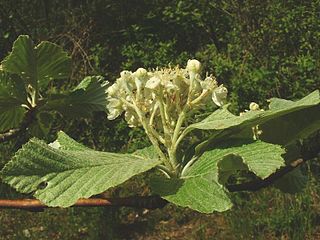
Sorbus is a genus of about 100–200 species of trees and shrubs in the rose family, Rosaceae. Species of Sorbus (s.l.) are commonly known as whitebeam, rowan, service tree, and mountain-ash. The exact number of species is disputed depending on the circumscription of the genus, and also due to the number of apomictic microspecies, which some treat as distinct species, but others group in a smaller number of variable species. Recent treatments treat Sorbus in a narrower sense to include only the pinnate leaved species of subgenus Sorbus, raising several of the other subgenera to generic rank.
Sorbus anglica, the English whitebeam, is a species of whitebeam tree in the family Rosaceae. It is uncommonly found in Ireland and the United Kingdom, with an entire British population estimated at about 600 individuals.

Sorbus arranensis, sometimes referred to as the Scottish or Arran whitebeam is a species of plant in the family Rosaceae. It is endemic to the island of Arran in Scotland.

Sorbus bristoliensis is a species of flowering plant in the family Rosaceae. It is known commonly as the Bristol whitebeam. It is endemic to the United Kingdom, growing wild only in the Avon Gorge and in the Leigh Woods area of Bristol. There are around 300 individuals as of 2016, and the population is thought to be increasing.

Sorbus eminens, the round-leaved whitebeam, sometimes classified as Aria eminens when the Aria subgenus of Sorbus is elevated to full genus, is a species of plant in the family Rosaceae. It is endemic to the United Kingdom. It is threatened by habitat loss.
Sorbus leptophylla, the thin-leaved whitebeam, is a species of plant in the family Rosaceae. It is endemic to Wales.
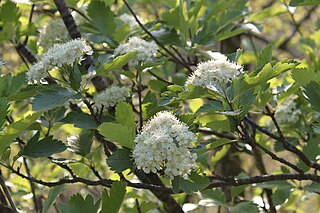
Sorbus leyana, also called Ley's whitebeam, is a species of plant in the family Rosaceae. It is endemic to the United Kingdom, where it is found in the wild at two sites in the Brecon Beacons, in Wales. It is threatened by habitat loss. There are about 16 examples left in the wild. Seeds have been collected by the Royal Botanic Gardens, Kew.
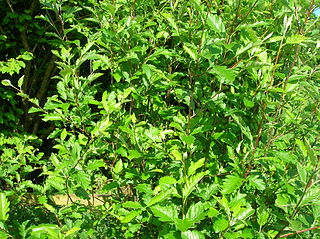
Sorbus pseudofennica is a species of plant in the family Rosaceae. Endemic to the Isle of Arran in Scotland, it is threatened by habitat loss. It is thought to be a naturally occurring hybrid between S. arranensis and S. aucuparia, probably with additional backcrossing with S. aucuparia. Sorbus arranensis is itself a hybrid between S. rupicola and S. aucuparia. Apomixis and hybridization are common in some groups of Sorbus species.
Sorbus subcuneata, the Somerset whitebeam, is a species of plant in the family Rosaceae. It is endemic to coastal north Devon and west Somerset in the United Kingdom. It is threatened by habitat loss.
Sorbus vexans is a rare tree in the family Rosaceae. It is endemic to England. It is found along the coast between Culbone in Somerset and an area just west of Trentishoe in Devon. It can be seen in the Exmoor National Park. It is threatened by habitat loss.
Sorbus wilmottiana, the Willmott's whitebeam, is a species of whitebeam in the family Rosaceae. It is endemic to England, and is found in the Avon Gorge, in Somerset and Gloucestershire. It is threatened by habitat loss.

Sorbus aria, the whitebeam or common whitebeam, is a European and Near-Eastern deciduous tree, the type species of the subgenus of the whitebeams. Typically compact and domed, with few upswept branches and almost-white underside of the leaves. It generally favours dry limestone and chalk soils. The hermaphrodite cream-white flowers appear in May, are insect pollinated, and go on to produce scarlet berries, which are often eaten by birds. Developed for garden use are the cultivars S. aria 'Lutescens', with very whitish-green early leaves, and S. aria 'Majestica', with large leaves. Both have gained the Royal Horticultural Society's Award of Garden Merit.
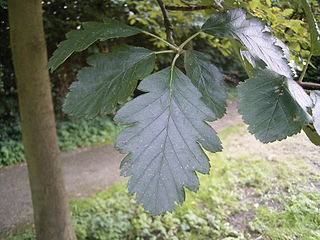
Sorbus intermedia, the Swedish whitebeam, is a species of whitebeam found in southern Sweden, with scattered occurrences in easternmost Denmark (Bornholm), the far southwest of Finland, Estonia, Latvia and northern Poland.

Sorbus × hybrida, the oakleaf mountain ash, Swedish service-tree or Finnish whitebeam, is a hybrid species of whitebeam native to Norway, eastern Sweden, southwestern Finland, and locally in Latvia.
Sorbus admonitor, also called the no parking whitebeam, is a species of whitebeam tree found in Devon, United Kingdom.

Sorbus devonensis is known by the English name of Devon whitebeam and locally as otmast. It is a species of whitebeam tree in the family Rosaceae. It is endemic to the British Isles, growing wild only in areas of Devon, Cornwall, Somerset and Ireland.
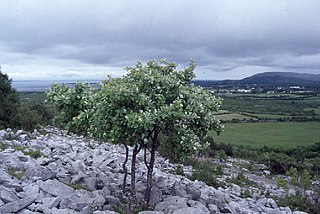
Sorbus hibernica, the Irish whitebeam, is a species of whitebeam endemic to Ireland. It occurs in most counties, usually as scattered individuals, or in small groups. It is sometimes treated as a species in the genus Aria, as Aria hibernica.
Sorbus scannelliana, Scannell's whitebeam, is a species of whitebeam endemic to Ross Island near Killarney in southwest Ireland. It is one of the rarest tree species in the world; only five individual plants are known.
Sorbus leighensis, the Leigh Woods whitebeam, is a rare species of whitebeam, a flowering plant in the rose family.
